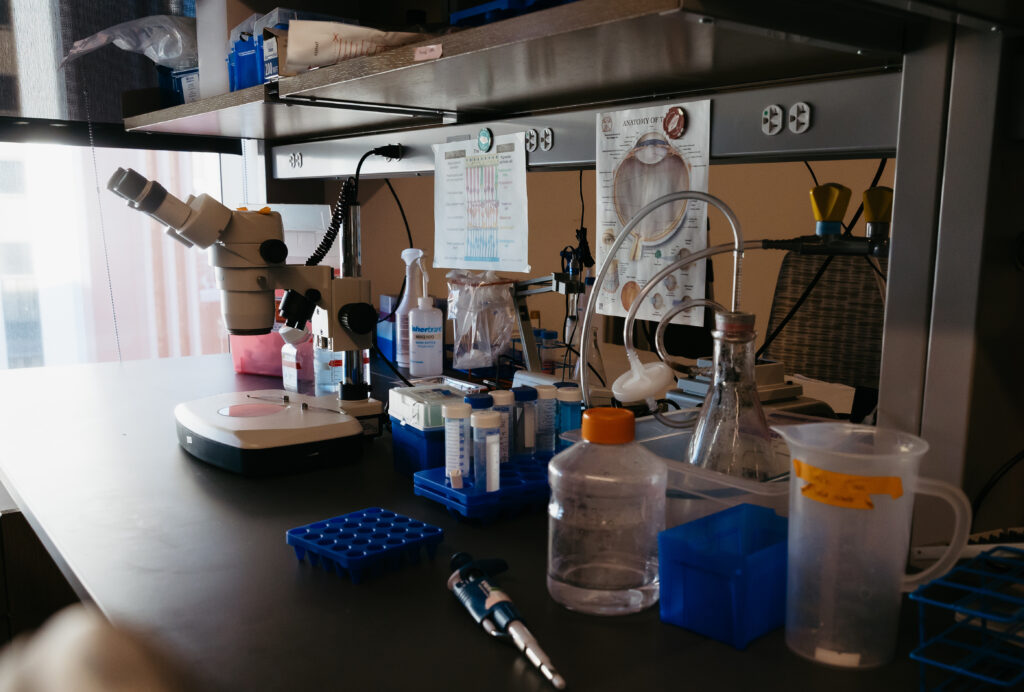Pitt’s Eye and Ear researchers have already lost more than $4 million in federal funding for three major grants, interrupting promising research.
In fiscal year 2024, the University of Pittsburgh was sixth in the country in research funding to institutions from the National Institutes of Health (NIH), with $661.2 million in awards. But this year, the University has lost $42.4 million in research funding cuts, including three major grants to the Departments of Ophthalmology and Otolaryngology.
José-Alain Sahel, MD, Distinguished Professor, Eye & Ear Foundation Professor and Chair of the Department of Ophthalmology and Director of the UPMC Vision Institute, along with colleagues Leah Byrne, PhD, Morgan DiLeo, PhD, and Joseph Martel, MD, and an international partner with unique expertise, received an initial grant of $3 million from the Department of Defense to fund the development of the next generation of optogenetics for restoring vision. The grant was very successful, with the program officer visiting in the early fall of 2024 offering to support a new grant to perform the next steps. This continued progress would enable the launch of a clinical trial to restore high-resolution vision.
However, “the whole vision program under which that project would be funded was no longer available and the officer left,” Dr. Sahel said. “I am now seeking alternative sources of funding as this approach is highly promising, and there is no alternative for these blind patients. Opportunities are limited, e.g., because the project included a key non-US partner, it is not currently possible to apply for NIH funding. Several other projects involving outstanding international partners, even at a small scale, were not considered for evaluation and will have to be resubmitted without these key experts, reducing the scope and ambition of the programs.”
In the Department of Otolaryngology, Chris Cunningham, PhD, had a project seeking to uncover the molecular mechanisms that regulate the trafficking and localization of essential auditory protein complexes in sensory hair cells, which convert sound waves into neural signals. A key focus was understanding how mutations associated with hearing loss disrupt these processes. As hearing loss is one of the most prevalent sensory deficits, with no FDA-approved biological therapies, there is a critical need for biological therapies capable of restoring natural hearing.
Already, the team has identified novel genes linked to genetic forms of deafness and begun generating mouse models to investigate their function. “Critically, we are also developing gene therapies designed to restore hearing in these models,” Dr. Cunningham said. “By identifying new molecules and regulatory checkpoints essential to auditory function, this research holds significant promise for the development of gene therapies and other therapeutic strategies to prevent or treat hearing loss.”
The project was originally funded at $3.2 million over five years but was unexpectedly terminated after just one year—resulting in a loss of $2.5 million in committed support. Substantial resources have already been invested, and exciting early progress was made. However, this abrupt loss of funding now threatens to derail the project entirely, according to Dr. Cunningham, who added, “Multiple highly skilled personnel—including graduate students and postdoctoral fellows in active training—are supported by this work. Without continued support, the models, therapies, and momentum we have built are at serious risk of being lost.”
Michele Insanally, PhD, was investigating the neural basis of auditory perception and learning. Her project involved trying to understand how the brain flexibly gates the behavioral relevance of sounds in dynamic environments using cutting-edge techniques including high-density neural recordings, optogenetics, and computational approaches. “We lack a fundamental understanding of how the brain processes acoustic signals that ultimately result in hearing and the ability to communicate and navigate complex environments,” Dr. Insanally said.
The results from the proposed experiments were expected to provide critical insights into improved diagnosis and treatment of hearing deficits caused by disease or injury and inform targeted therapies for central auditory processing disorders.
The project has already yielded significant findings and resulted in a high impact manuscript currently in revision at Nature, a top scientific journal. Dr. Insanally was invited to numerous high-profile conferences and institutions to discuss the findings as a keynote speaker and invited lecturer. The project was funded for a total of $2.7 million for five years but was terminated for non-scientific reasons after two years, resulting in what Dr. Insanally called a “devastating loss of $1.7 million.”
In 2025, both Departments jumped in the rankings of NIH funding. As of 2024, Ophthalmology is #5, receiving $15,729,241 in NIH funding in 2025. Otolaryngology-Head & Neck Surgery is #2, amassing $13.7 million in 2024.
As of June 9, Pitt joined other major research universities in filing a brief in federal court making the case that breakthroughs from academic research save and improve lives and build economies. And they require federal funding to do so.
To donate to the Eye & Ear Foundation, which supports the Departments of Ophthalmology and of Otolaryngology-Head & Neck Surgery at the University of Pittsburgh, click here.
